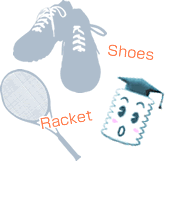
Episode 26: Springs That Support Athletes
Hello everyone.
The summer Olympics are scheduled to be held in London, England this year.
As I've described in previous installments of Springs and Technology, elasticity, or springs, are used in every sporting event. Chief among those sporting events is the athlete's body, of course. That's right. I'm talking about human muscle.
Athletes earn the right to participate in the Olympics, only after putting their muscles through arduous, painful training. That's why the Olympics are a competition among athletes that possess only the most extreme springs, or human muscle.

Every four years, athletes come from all corners of the globe to compete in the summer Olympics. For that reason, the opponent to which athletes worry most about losing is "jet lag."
Many of these athletes have much experience in competing in sporting events all around the world, and often say that they have their own methods for overcoming this tough competitive force. The most common method is said to be build up a sweat by running.
However, there are some exceptions: There are some that use target practice as their method. Marksmanship athletes are said not to be great gymnasts. If they tone their muscles, and there is even the slightest difference in their muscle tone or their physical condition, they say that they will become unsteady when shooting targets, if their muscles get weaker on the day of the competition. Marksmen say that to overcome jet-lag, they simply get to the country of the event early.
The Olympics hosts a variety of competitions, but these different competitions also have a variety of approaches.
For example, let's take a look at how springs are used, by thinking of competitions where athletes wear athletic shoes and where they are bare-footed.
First, we can classify competitions where athletes wear athletic shoes further into those that use an appliance, and those that do not. In those that use an appliance, the appliance itself possesses elasticity. They include using a ball or racket of some sort. The shot-put competition uses a metal ball which has no elasticity, but the shoes of the athletes where are elastic.
For those that do not use an appliance or tool, for example in the track and field competitions, athletes wear shoes that are meticulously calculated for that athlete's body and weight for the proper elasticity.

You may be wondering about competitions where athletes go bare-footed.
Of course Judo, Japan's proud national sport, is what I am referring to. The tatami mat upon which this sport is practiced has elasticity, but that's not all.
Actually, there are as many as 2,000 individual support posts under the tatami mat. Each one of these acts as a spring. That's why these athletes rarely suffer any major injuries. Athletes that compete in gymnastics also go without shoes. I would be very concerned if they decided to compete on concrete!
There are also many other sporting events that use springs. You might watch for springs in the Olympics this summer. Keep your eyes open for diving boards in the diving competitions, or in the speed-swimwear that is often the subject of much discussion at swimming events. They use a very powerful elastic technology.
This is as far as I can go this time.
Once the Olympics are completed, and all the athletes return to their home countries as great heroes for having competed for their country on the world stage. Then, the season will slowly begin to change toward the autumn. That season has a whole other range of sporting events. I'd like to know what all my readers do to maintain their physical health. I'm sure some of you like to jog. I wonder if you can also train the elasticity (pliability) of your brain.
See you next time!
Written by Banekko (a child of spring)




